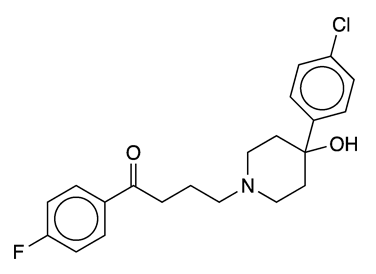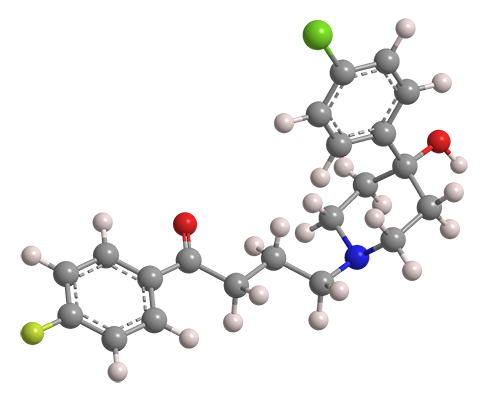What molecule am I?


Haloperidol is a venerable antipsychotic drug that is used to treat schizophrenia, Tourette syndrome, bipolar disorder, and other conditions.
Paul A. J. Janssen at Janssen Pharmaceutica (Beerse, Belgium), discovered haloperidol in the mid-1950s. Clinical trials began in 1958, but the US Food and Drug Administration did not approve the medicine until 1967. It was first marketed by McNeil Laboratories (Fort Washington, PA) under the trade name Haldol.
Haloperidol has many side effects, some of them serious; but it is still a widely used medication. In 2018, Kristen Brennand and colleagues at the Icahn School of Medicine at Mount Sinai Hospital (New York City) and Eli Lilly (Indianapolis) used haloperidol and 134 other drugs (not all of them antipsychotics) to develop a new screening method for schizophrenia drugs. Their impetus was that as many as 30% of schizophrenia patients are unresponsive to existing drugs, and current drug screens are not effective.
The researchers gathered skin cells from 24 individuals, 12 with schizophrenia and 12 controls. They converted those cells to stem cells and then to neural progenitor cells. When the scientists exposed the neural cells to the test drugs, the cells derived from schizophrenia patients showed sharper disease-related gene expression responses to antipsychotics than did the cells from the control studies.
This proof-of-concept experiment revealed the possibility of using similar screening methods to evaluate potential anti-schizophrenia drugs. The authors also suggest that a patient’s own cells might be used to determine which medicines are most effective against that individual’s disease.
Haloperidol hazard information
| GHS classification*: acute toxicity, oral, category 3 | |
| H301—Toxic if swallowed | |
| GHS classification: skin irritation, category 2 | |
| H315—Causes skin irritation | |
| GHS classification: skin sensitization, category 1 | |
| 317—May cause an allergic skin reaction | |
| GHS classification: eye irritation, category 2 | |
| H319—Causes serious eye irritation | |
| GHS classification: specific target organ toxicity, single exposure, respiratory tract irritation, category 3 | |
| H335—May cause respiratory irritation | |
| GHS classification: reproductive toxicity, category 2 | |
| H361—Suspected of damaging fertility or the unborn child | |
*Globally Harmonized System of Classification and Labeling of Chemicals. Explanation of pictograms.
Haloperidol fast facts
| CAS Reg. No. | 52-86-8 |
| Empirical formula | C21H23ClFNO2 |
| Molar mass | 375.86 g/mol |
| Appearance | White to faintly yellow powder |
| Melting point | 151.5 ºC |
| Water solubility | 14 mg/L |

Learn more about this molecule from CAS, the most authoritative and comprehensive source for chemical information.
Molecule of the Week needs your suggestions!
If your favorite molecule is not in our archive, please send us a message. The molecule can be notable for its current or historical importance or for any quirky reason. Thank you!
Stay Ahead of the Chemistry Curve
Learn how ACS can help you stay ahead in the world of chemistry.

